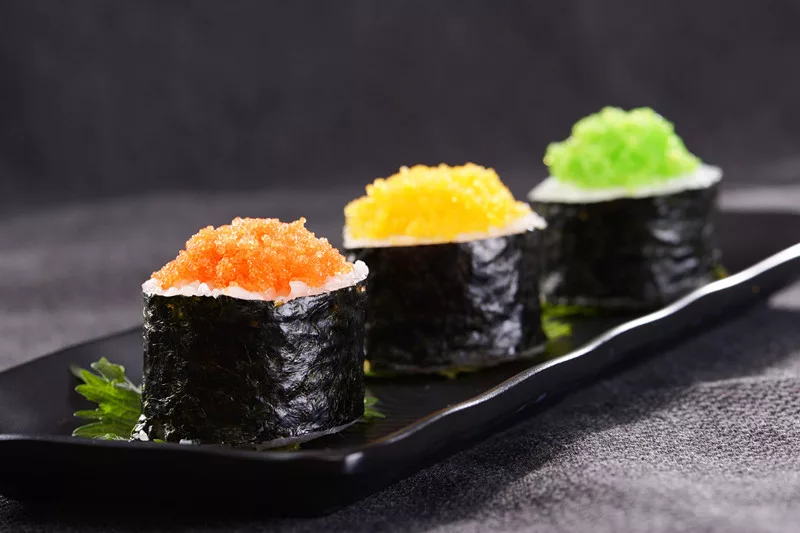Tobiko is an ingredient that is popular tobiko is a popular ingredient in Japanese dishes, specifically for sushi. It’s the name given to there” (eggs) that are part of the flying fish. They are commonly used to garnish dishes and add colour and flavour. In this post, we’ll go over the meaning of tobiko, its origins, and the ways it is used in different recipes and address many frequently sought-after concerns.
What Is Tobiko?
Tobikos can be described as the Roe that is found in the flyfish. It typically occurs in the oceans that are part of East Asia. Eggs are tiny usually approximately 1 millimetre across They are also characterized by an incredibly crunchy texture. Tobiko can be found in various shades, such as black, red, orange, and green. The variations in colour are because of different spices and flavours added to the product during processing.
The distinctive texture and design create a distinctive texture and appearance to sushi and sashimi in addition to various other cuisines. Its light, lightly salty flavour is well-suited to the delicate flavour of the fish.
The Origins of Tobiko
Tobiko has been a staple of Japanese food since the beginning of time, but its popularity has grown across the globe in recent years. Flying fish, typically coming from regions of East Asian regions, are the origin of the tobikos. Tobiko was traditionally employed to flavour Japanese sashimi and sushi dishes to give it a little flair and taste.
Tobiko is often linked to sushi rolls, it’s utilized in other meals, including salads, rice bowls, or even over pasta.
How Is Tobiko Processed?
Tobiko production begins with the collecting of eggs that are collected from fly fish. After being collected, eggs are cleaned and then lightly salted in order to keep them fresh. After that, they’re often flavoured with various ingredients, resulting in the bright hues that tobiko is famous for.
- orange Tobiko: A nature of the colour of the Roe is the colour of orange. It’s usually the most popular type of sushi that is served in restaurants.
- Black Tobiko: This type of tobiko is typically mixed with squid, giving it a darker hue and a slightly stronger taste.
- Red Tobiko: This kind of drink is prepared by adding chilli to the mix, providing the roe with a hot spice.
- Tobiko: Green Tobiko The color of the tobiko has a flavour of wasabi. It adds a zingy spice to the Roe.
Certain variations of tobiko may include more ingredients, like miso, soy sauce, or yuzu, to increase the taste.
Nutritional Value of Tobiko
Tobikos isn’t only an excellent ingredient in sushi or other meals, it’s also an extremely healthy option. It’s a rich source of proteins, omega-3 fatty acids and vitamin B12, among others. B12. This is a summary of the nutritional value of the tobiko in 100 grams of it:
- Calories About 150 calories
- Protein: 15-20 grams
- Fat 10-12 grams
- Carbohydrates 4 – 6 grams
- Omega-3 Fatty Acids: 1.5-2 grams
Tobiko is also very low in cholesterol when compared with other varieties of fish roe which makes it a healthy choice. But, because of the salt content, it is important that you consume it in moderation.
How Is Tobiko Used in Dishes?
Tobikos is an ingredient that can be used in a variety of ways which is used in a myriad of ways Japanese and other dishes. Here are the most favoured ways you can enjoy it:
- Sushi Rolls: Tobikos is often used to garnish sushi rolls. It provides crunch as well as a blast of flavour. It is particularly good with tuna and salmon, as well as avocado sushi rolls.
- Sashimi In some cases Tobiko can be served with Sashimi in order to boost the flavour of the fish.
- Salads: Tobikos is a great addition to salads to give colour and texture, as well as complement fresh greens and dressing.
- Rice Bowls also known as Donburi rice bowls decorated with tobiko create a tasty food. They are often served with eggs, seafood, or even fruits and vegetables.
- Pasta Though not a typical tobiko is a great choice to garnish pasta dishes, specifically when it comes with seafood.
- tartares and appetizers: Tobiko can also be added to tartare, or served as a topping to appetizers, canapes and desserts.
Conclusion
Tobikos is an attractive, crisp, scrumptious, and delicious ingredient that can be used to spice up many food items. Its variety and high nutritional value make it a desirable ingredient in both traditional Japanese culinary styles and international dishes. When you’re enjoying sushi rice bowls or salads it’s sure to enhance your meals. Be sure to drink the food in moderation so that you can reap its full benefits without exaggerating the salt.
FAQs
1. Does Tobiko healthy?
Yes, tobiko is a healthy ingredient. It is rich in protein, omega-3 fat acids, as well as essential vitamins. It is important to take it slowly because of the sodium material.
2. Is Tobiko the Same as Caviar?
The two differ. Caviar refers to the roe from sturgeon fish. This is a larger size and has a smoother taste compared to the caviar. Tobiko is a little smaller with more crunch and more mild, salty taste.
3. Can I Eat Tobiko If I’m Allergic to Fish?
Tobiko is made of eggs from fish, which means it’s not appropriate for those suffering from fish allergies. You should consult the establishment or manufacturer to ensure the product is appropriate for people who suffer from specific food allergies.
4. Is Tobiko Vegan-Friendly?
Tobiko isn’t vegan because it’s made of fish. There are however alternative plant products that resemble it, together with substances like seaweed, or any other plant-based product.
5. How Long Does Tobiko Last?
Tobiko is a food item with a shelf-life that is about one to two weeks if placed in a fridge that has been properly maintained. If you store it in a container that is sealed, it will last longer. However, it must not be eaten before the expiration date.












